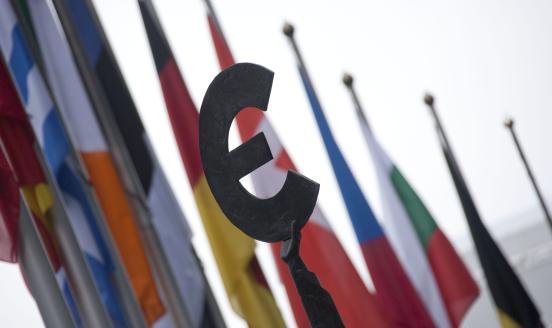Sharing the burden
Jean Pisani-Ferry goes over the reasons why it is more complicated for the EU to put toegether a sustainable fiscal stimulus package- and why it's important that the EU overcomes these difficulties to play its role on the global scene.
According to the latest International Monetary Fund forecasts, economic contraction in 2009 is going to be somewhat sharper than in the US. Private forecasters do not disagree. Yet in proportion of GDP, the size of the stimulus packages put in place in Europe are at best half the size of the US recently enacted ARRA stimulus, and unlike it several of them are rear-, rather than front-loaded . Calculations by David Saha and Jakob von Weizsäcker of Bruegel assess the 2009 fiscal impulse in the EU is going to be 0.9% of GDP against 2% in the US. So Europe will clearly fall short of the 2 percent of GDP advocated by the IMF.
How can this discrepancy be explained? In 2007, the general government deficit was 0.9 percent of GDP in the EU against 2.6 in the US, and the gross public debt stood at 59 percent of GDP against 61 percent in the US. The underlying aggregate fiscal situation therefore cannot account for differences in reactions.
Furthermore, policy interest rates are lower in the US than in the EU, where the ECB is still divided on the appropriateness of a zero interest rate policy, so relative fiscal timidity in the EU cannot be explained by greater reliance on the monetary instrument. The fact is that both on the fiscal and on the monetary sides, the EU is doing less than the US.
Can it be because the underlying economic situation is better? It is true that Europe as a whole does not suffer from a real estate crisis of a magnitude comparable to the US crisis (some countries such as Spain, Ireland and the UK do, but Germany does not). Also, although European banks account for 39 percent of the financial sector losses on U.S.-originated securitized debt worldwide, the banking system is in a somewhat better shape: of the 50 largest banks 15, representing 40 percent of pre-crisis market capitalization, have received public capital injections in the EU, while the corresponding numbers are 23 and 76 percent in the US. Moreover, the wealth loss is more significant for US households and as a consequence they are bound in the coming years to stop relying on the revaluation of their assets and increase their saving rate from zero to a more standard level, thereby depressing demand. The same does not hold in Europe (though the UK is not that different from the US) because households more often rely on pay-as-you go retirement regimes and because in recent years their saving rate has remained at significantly higher level.
It would however be wrong to stop here. Europe has problems of its own and they contribute to the depth of the recession envisaged by forecasts. Especially the largest economy within it, Germany, is severely affected by the collapse of world trade and its GDP is set to decline more than those of its neighbours. Also Central and Eastern Europe, whose fast-rising demand has for many years fuelled growth in old Europe, has been hit hard by the sudden stop of capital inflows and several countries within it have been forced to request assistance from the IMF. And optimism about Europe’s growth has been several times dashed since the crisis began. So complacency would be misguided.
The true reasons for Europe’s cautious attitude lie elsewhere. To start with, in continental Europe reservations vis-à-vis macroeconomic activism are widespread. Many see it as an ill-advised response that risks adding instability to instability and creates problems for the future. The quick conversion of the European Commission to fiscal support at the end of 2008 was in fact a surprise, and Germany was for some weeks reluctant before it accepted to take its part in the package. So there is an issue of policy philosophy that cannot be ignored. Facts, and discussions within the G20 (apparently the G7 meeting in Rome did not address the matter as a priority) may lead the Europeans to reconsider, but their starting point is clearly not the same than that of the US.
Furthermore Europe’s fiscal constitution, the Stability and Growth Pact, makes things complicated. It includes flexibility for exceptional times, but in order to make clear that it remains in force the European Commission has recently formally labelled as excessive the deficits of five countries (including France, Ireland and Spain), and it has issued reports accordingly. Although the reports do not call for immediate remedial, their publication highlights the schizophrenic character of the European policy agenda. When the European Commission calls for fiscal stimulus in November and warns against deficits in February, this is not an incentive to go any further.
More fundamentally, Europe does not have one fiscal policy but twenty seven (not counting the policy of the EU, which does not have a federal budget of meaningful magnitude) and this represents a significant handicap to fiscal activism. As bluntly explained by Willie O’Dea, an Irish minister, from each country’s point of view “the best sort of fiscal stimulus are those being put in place by [its] trading partners.
Ultimately these will boost demand for [its] exports without costing [it] anything”. This classic coordination failure plays a role in explaining the size, at least the composition of the stimulus packages that tend to be biased towards domestic industries and take the form of supply, rather than demand-side measures. The Commission’s call for a concerted stimulus was an attempt to overcome the risk of coordination failure but in fact countries have responded very unevenly. While Germany’s programme amounts to 1.4% of GDP in 2009, the French one is significantly smaller (0.8%) and Italy has not put forward any meaningful fiscal boost.
Beyond strategic behaviour, a major motive for that is that the fiscal situations and the corresponding constraints are themselves very uneven. One reason why Italy is cautious is that its public debt ratio already above 100% of GDP and that its rating is only A+, not AAA as for Germany and France. The same applies to Greece and now Spain, which recently lost the coveted AAA rating. Meanwhile, Hungary and Latvia are under IMF programme and cannot contemplate any kind of budgetary support. Within the euro area, the diversity of fiscal situations was long concealed by the low level of bond spreads but since the onset of the crisis, and especially since the Lehman bankruptcy, they have started to widen, reaching almost 300 basis points in late January before receding somewhat. Credit Default Swaps have moved in parallel. Risks of outright defaults are remote but there is a distinct possibility of funding crisis of a euro area country. This risk acts as a threat for the other governments and they are therefore inclined to err on the side of caution.
The upshot is that although the aggregate initial fiscal conditions are identical in the US and the EU, market constraints on debt issuance by individual EU countries can be already much more significant than in the US. US Treasury securities are in high demand worldwide and but this is not true of
European government securities. Only the German Bund and to some extent French securities benefit from a demand effect – and only to a very limited extend. Other government securities are less in demand and some are regarded with caution by investors. This means constraints for Europe.
What can be done? There is no easy way out. Europe will not create a federal budget because that would make joint macroeconomic stimulus easier. It is not going to renounce to the principle that each country is responsible for its own debt. It needs however to act to prevent a worsening of the problems that have started to emerge, with potentially dire consequences for the region’s ability to deliver a sustained and substantial fiscal stimulus. Discussion has started on various plans of unequal relevance, from the creation of a joint debt agency to the setting up of a European equivalent of the IMF or bilateral support agreements between strong and weak countries.
Once again therefore the EU’s ability to deliver globally hinges on its ability to solve its internal problems.
Its international partners should remind it that in the midst of a crisis of this magnitude, Europe needs to play its part in the global game and that it cannot afford to be obsessed by its internal issues. But they also need to understand where these problems are real ones and help find creative ways to address them.



